Container gardening or pot gardening/farming is the practice of growing plants, including edible plants, in containers rather than in the ground. In gardening, a container is a small, closed, and usually, a portable object used to grow live flowers or Used for displaying plants. It can be a pot, box, tub, basket, tin, barrel, or hanging basket. Whether you’re growing vegetables, flowers, or herb plants in containers, you’ll find the greatest success when you use containers with adequate drainage.
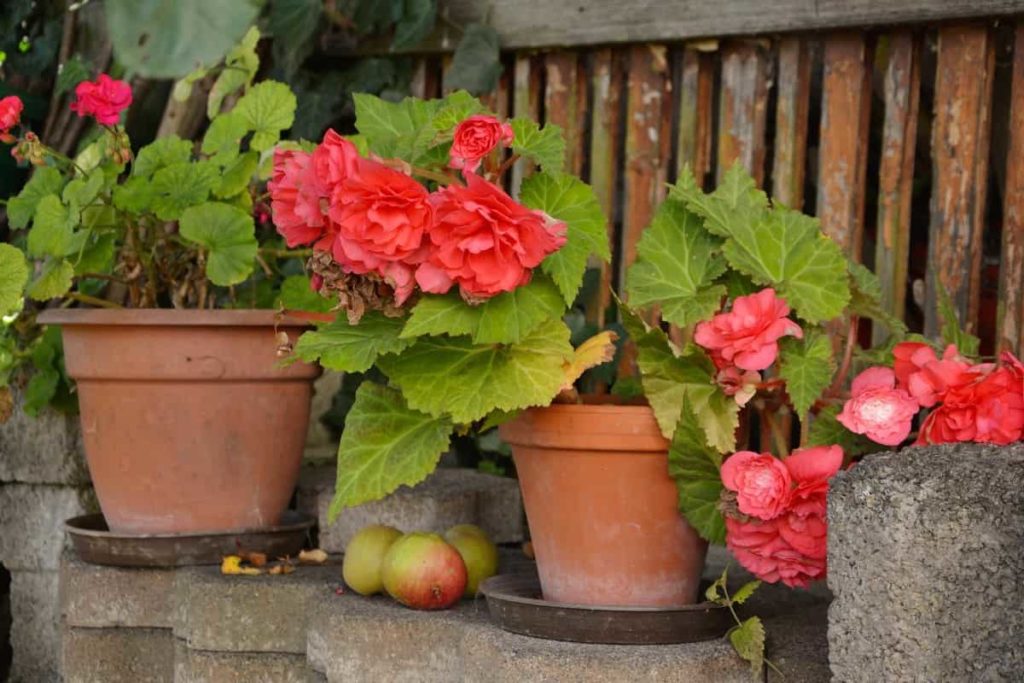
Container plants add beauty to all areas and thrive on windowsills, patios, balconies, doorways, greenhouses, and rooftops. The possibilities are endless. You can use almost anything for gardening as long as it is large enough, has good drainage, and is made of food-safe materials. Planting and maintaining a container garden is the easiest form of gardening.
All you need is some supplies like a container, potting soil, plants that play well together in a growing environment, slow-release fertilizer, and water. Container gardening is a fun and satisfying way to grow your favorite plants. Here are 12 key rules for container gardening that will get you off to a strong start.
12 key rules for successful container/pot gardening
Key elements of successful container gardening
Drainage is important – Proper drainage may be the biggest factor in determining whether container-grown plants survive or die. However, the plants can sink or rot if the soil in the container or pot does not drain well. Therefore, all containers should have adequate drainage holes for excess water drainage. Containers intended for indoor use are usually sold with a matching saucer. If you buy a container that does not have drainage holes or has insufficient drainage holes, you will need to make or enlarge them yourself.
Fertilize before planting – Container plants can become nutrient deficient as frequent watering leaches nutrients from the containers. Many slow-release and time-release fertilizers are available for container plants, but a quality granular all-purpose organic fertilizer is a good option.
Water and feed correctly – Watering a container garden is more art than science. Although plants vary in their water needs, container plants tend to dry out much faster than plants planted in the ground—especially if they receive full, hot sun in containers that heat up quickly, or if the containers are kept in a hard place, hot surfaces, such as concrete or asphalt.
Most garden plants prefer moist, but not wet, soil. You may need to water the container once a day and sometimes twice in hot weather. To test soil moisture, stick your finger as far as another finger into the soil. If your finger feels dry, it’s time to water it.
Light and temperature for containers – Your plants need adequate sunlight to grow well. Choose a spot where your planter gets plenty of sunlight during the day. To choose the perfect spot for your planter, place it where you want it and then time how long the sun will hit it. Keep moving your pots according to their light and temperature needs.
In case you missed it: 15 Key Rules for Successful Terrace Farming/Gardening: Check How this Detailed Guide Helps Beginners
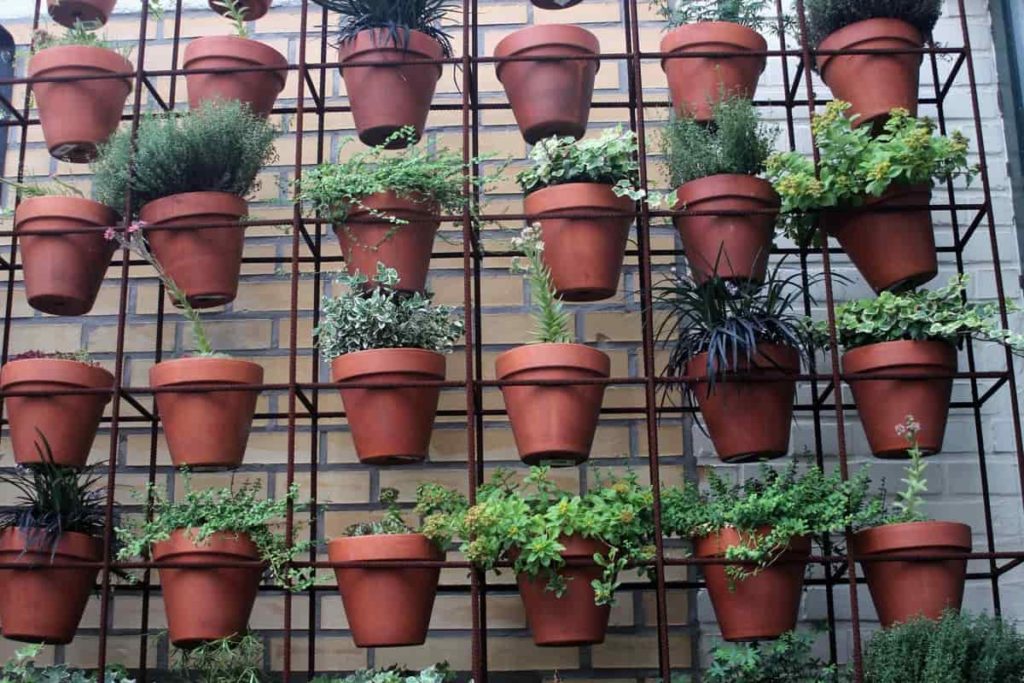
Tips to succeed in container selection
Choose the right container – Like plants, containers have their characteristics, including weight, sensitivity to weather changes, and appearance. You’ll also want to consider your budget, space, and style when choosing a container. The larger the container size, the less watering you’ll need, but whatever you choose, always ensure there are holes in the bottom of the container for drainage.
Common pot types
- Terracotta: Versatile and inexpensive, terracotta containers are also called a pottery. You can find them decorated in colored glazes. The only downside to using terra cotta is that it is somewhat fragile. It will chip and crack if handled too roughly and damaged by freezing temperatures (store them indoors during the winter in vacant and cold areas).
- Wood: Choose a durable wood, such as non-toxic or cedar-treated pine.
- Concrete: Concrete containers can withstand any weather. Be careful where you place concrete planters, as they are extremely heavy and difficult to move, especially when they are filled with soil and plants.
- Metal: Galvanized buckets and tubs are great options for container gardens. Be careful when using metal pots as they heat up quickly in the sun and cook your plants. To protect the container plants, line the container with garden cloth and place it in a shady spot.
- Plastic, fiberglass, or resin: These containers can be made like any other type (but at a lower cost and lighter weight). The container isn’t as high quality and won’t last forever, but it can provide a certain look.
- Recycled containers: Select old baskets, tin buckets, birdbaths, and water containers to house your favorite plants. Thrift is stylish and rustic.
Key rules for creating a successful container garden
Growing media – When choosing growing media for your container, you need to choose something well-aerated, well-drained and can hold enough water for plant growth. Soilless media are the best option for container gardening. They are usually peat, coconut coir, vermiculite, bark, and perlite. Avoid using garden soil; it can contain weeds and pathogens and often does not yield enough to be used in containers.
Planting and care – After choosing your plants, container, and growing media, it’s time to plant! Before planting, be sure to moisten your growing media thoroughly. Then fill your container. Leave an inch of space between the container edge and the soil. It will help prevent water from seeping into your container.
If growing your plants from seed, plant at the depth indicated on the seed package. It’s usually a good idea to monitor the seeds and then thin them to the spacing indicated on the package because not all seeds will germinate. Although containers may seem small when first planted, make sure you follow proper spacing (a little closer is fine, but not too close).
Plants that are close together can shade each other. However, it can also increase the chances of disease development due to reduced air circulation. If you are planting different types of plants together, ensure they have the same growth needs (sun exposure, moisture needs, etc.). Also, keep the plant’s size, shape, color, and texture in mind when designing your containers.
In case you missed it: Indian Gardening in the USA: For Home, Containers, Backyard, Vegetables, Flowers, Herbs, and Fruits
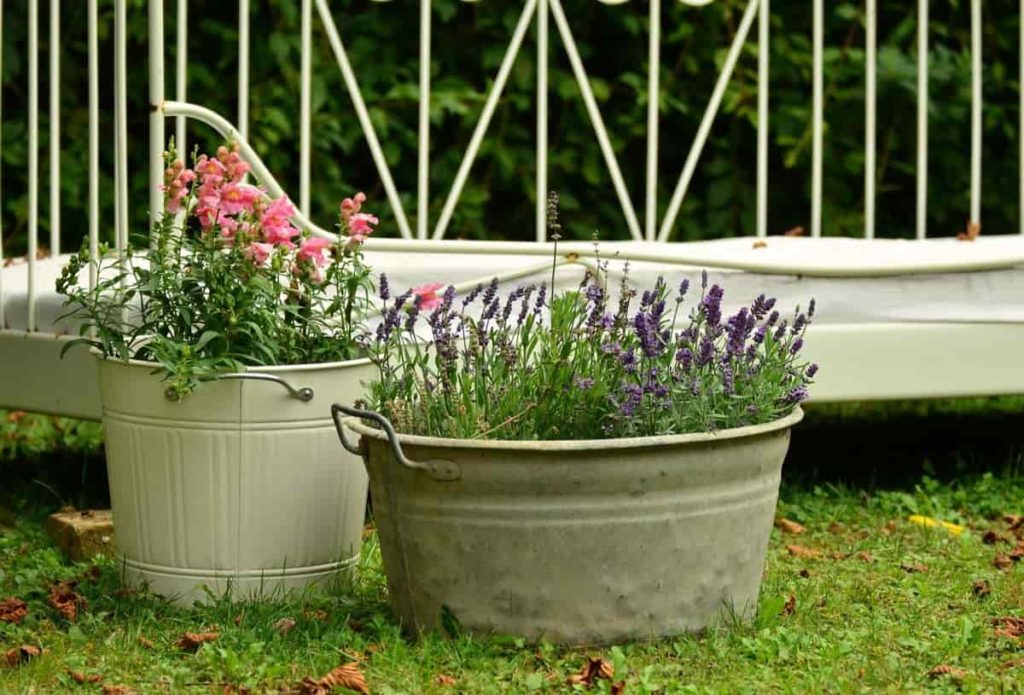
The key principles of container gardening
- Pair plants with a container that accommodates their growing root system.
- Provide a suitable soil mix for plant selection.
- Make sure the drainage will be adequate for the type chosen.
Container gardens are more manageable than growing in ground-level beds. They also allow for greater control over growing conditions. You can adjust the soil texture, fertilizer, and water needs of specific plants, and you can place containers, so they’re getting the right amount of sunlight for each variety. Placing pots or containers in ideal locations will save water and produce healthier plants that can fight off pests more easily.
Important factor in container gardening for reducing production cost
The most essential part of container gardening is choosing the right container. The more space you can give your plant’s roots, the better they will grow. Most plants need at least 12 inches of soil to grow well, but larger vegetables need more space. Interesting containers often make plants attractive, and the varieties available are almost endless. Color, size, and texture are important, but the most important consideration when choosing a container is whether it has adequate drainage holes.
Choose healthy plants – You can grow anything you want in a container and will thrive in a large enough pot. People prefer to grow flowers, vegetables, or herbs for their patio, porch, deck, or terrace. Enjoy a food feast by combining a few of each variety in one pot. For example, Strawberries and Lettuce taste as good as they look and make great companions for sun-loving annuals and perennials.
Key rules in a successful container garden for beginners
- Assess your light – People often overestimate how much sun their containers get. However, you can find a perfect plant for almost any amount of light; you need to know how much light your container will receive before choosing your plants. To determine how much direct light your container will receive, place it where you want it and then time how long the sun will hit it. Also, you can use a sun calculator to determine sunlight.
- Potting soil for container plants – Many people out there will tell you to fill your containers with junk, from peanut packaging to milk jugs. Doing so will make your container garden significantly lighter, but it will also make it harder to maintain as it will dry out faster. In addition, the more potting soil you use for plants, the more water retention you will have, giving plants a lot of margin for error in watering.
- Feed your plants – Most plants will need fertilizer added to your soil to thrive. You can mix a slow-release fertilizer carefully into the potting mix. To do this, mix a large batch of potting soil with compost in a bucket or fill your pot with potting soil and then mix in the fertilizer.
Key rules for selecting the best plants for container gardening
When choosing plants for containers, it is important to decide where they will be grown. The number one factor affecting the success of a container garden is matching the amount of sunlight available to the plants that thrive in that environment. Check plant labels or seed packets, and if planting several plants together, ensure sun-loving plants are grouped with sun-loving ones and shade-loving plants with shade.
Some plants do well in pots all year round. These include hardy evergreens such as Yucca, English Ivy, Variegated Euonymus, and Heuchera, and flowering plants such as Skimmia Japonica. Evergreens are great for year-round pot displays because they are always in leaf and therefore always have something to offer the display. Pair them with plants that bloom from spring to winter at different times. Planting long-flowering plants like perennial wallflowers, which can bloom 12 months of the year in mild conditions, will add to your display.
In case you missed it: How to Water Your Garden with Solar Power: For Home Gardening, Greenhouse, Polyhouse, and Outdoor
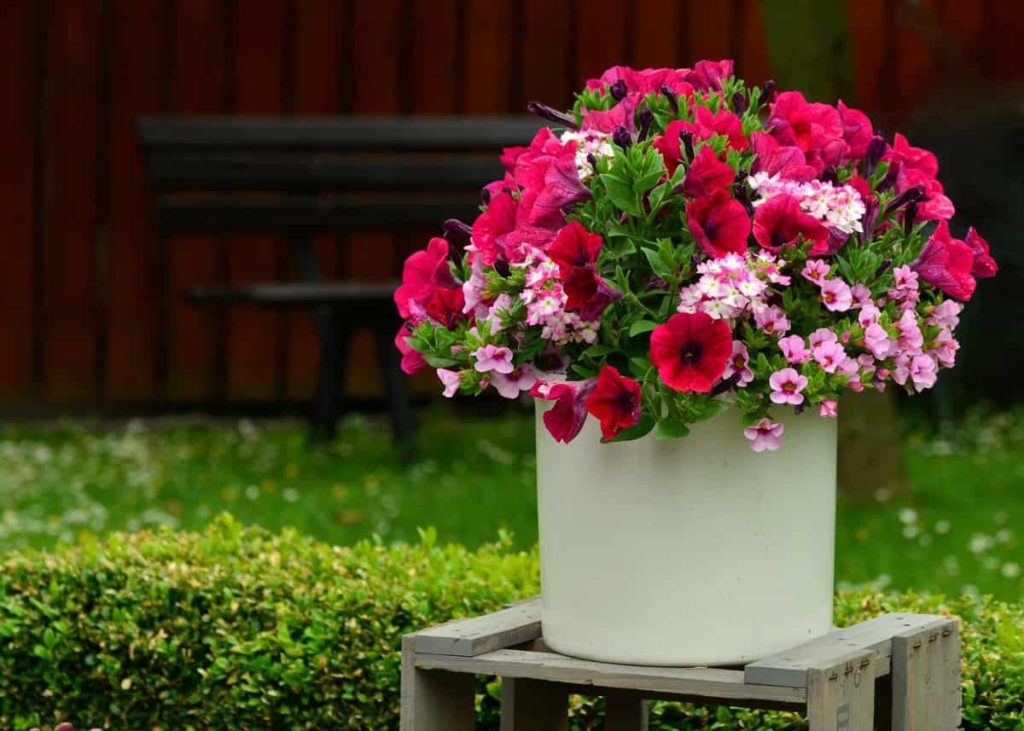
Easiest plants that grow well in containers
Herbs
- Annuals – Anise, Basil, Borage, Chervil, Cilantro/Coriander, Dill, Stevia, Summer Savory
- Biennials – Caraway, Parsley, Evening Primrose, Foxglove
- Perennials – Catmint, Chives, Fennel, Hyssop, Lavender, Lovage, Marjoram, Mint, Oregano, Rosemary, Sage, Sweet Bay, Tarragon, Thyme, Watercress, Winter Savory
Fruits
Apples (dwarf), Blackberries, Blueberries, Figs, Guava, Lemon, Lime, Oranges, Pomegranate, Raspberries, and Strawberries.
Bulbs/tubers/rhizomes
Agapanthus, Achimenes, Amaryllis, Anemone, Caladium, Canna, Clivia, Crocus, Daffodil, Hyacinth, Lily, Tuberous, Begonia, and Tulip.
Vegetables
Beans, Beets, Bok Choy, Cabbage, Carrots, Chard, Collards, Cucumbers, Eggplant, Kale, Lettuce, Mustard Greens, Onions, Green Peppers, Radish, Spinach, Squash, Tomatoes, and Turnips.
Flowers
Ageratum, Alyssum, Angelonia, Bachelor Button, Scarlet Runner, Begonia, Bracteantha, Marigold, Chrysanthemum, Roses, Zinnia, and Calendula.
Key rules for fertilizing container growing plants
- The easiest method to fertilize potted plants is to prepare a nutrient solution and pour it over the soil mix. Fertilizer is mainly absorbed by the plant roots and adds what is missing from the existing soil. Start fertilizing your container plants twice a week. Fertilize your houseplants once a week. Feed your container garden plants every two to three weeks.
- Apply a water-soluble (liquid) fertilizer to supplement slow-release fertilizers. Water-soluble nutrients are delivered directly to plant roots and are easy to apply. Just dissolve them in water and pour the liquid into the container to increase the nutrients.
- If the potting mix has been amended with compost, you don’t need to fertilize container plants for the first two to three weeks after planting. After this period, nutrient levels usually drop as plants use them up, and frequent watering removes nutrients from the soil. Therefore, succulent or tender annuals and perennials should be started about two to three weeks after fertilization. The frequency of fertilization depends on the method you use. For example, if you use a so-called liquid-soluble fertilizer, make an application every two to three weeks during the growing season.
- Fertilize every one to two weeks if faster growth is desired. Mix the soluble fertilizer according to the label directions and apply it to normal water. Add enough solution so that some liquid drains from the bottom of the container. If you use dry, garden-type fertilizer, apply it every three to four weeks. A half teaspoon of fertilizer per gallon of soil mixture spread evenly over the soil surface is sufficient. Watering after fertilization dissolves nutrients and transports them to the root zone. Watering the compost reduces the chance of compost damage to the stems and roots. Soil is perfect for container gardening.
Effective rules for preparing the soil for container garden plants
Fill your pots or containers with quality commercial potting soil. Never use soil directly from your garden, as it will harden into a solid mass when it dries. Quality potting soil should include a generous helping of some of the following amendments: peat moss, compost, perlite, vermiculite, and rotted manure. Cheap potting soil isn’t always a bargain, so read the label before buying.
Preparing your container for planting is easy but requires a little more than filling the pot with soil and adding plants. Soil is your plant’s bed and the foundation upon which plant growth depends. It is the medium through which plants gain access to moisture, nutrients, and oxygen. Not all plants need the same soil, so it’s important to know the soil combination each one needs and the function of each material.
In case you missed it: How to Start Hydroponic Farming/Gardening from Scratch in India: A Step-By-Step Guide for Beginners
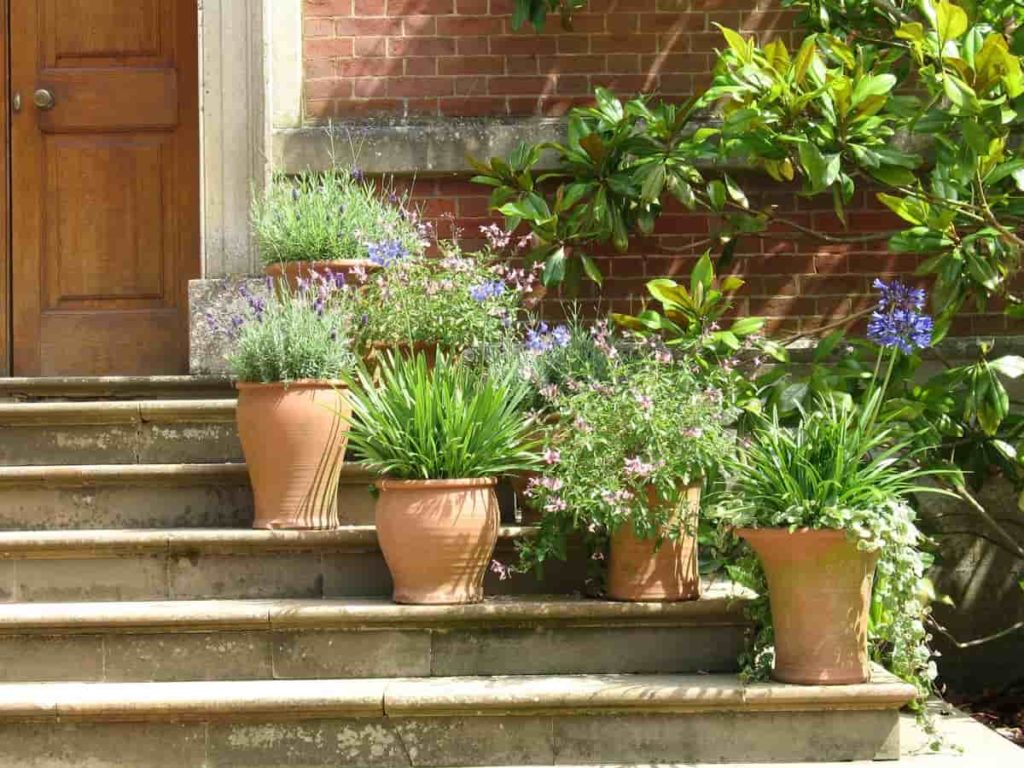
Organic matter (OM) is a dual-purpose medium composed of materials of various sizes that provide porosity for soil aeration and act as a sponge to hold water in small particles of matter. The most common organic material for containers is peat or coconut coir. Both will help containers retain moisture. Compost is the main type of organic matter that offers similar benefits in addition to being rich in nutrients.
Compost is usually obtained from decaying plant material or manure processed by insects. Sand is a granular rock material that aids in drainage in the container. Each container should have a little, but too much pot can dry out too quickly. Loam is equal parts silt, clay, and sand, each offering advantages and some disadvantages of each material.
Key rules for watering your container garden plants
- Container growing plants need more frequent watering than those grown directly in the garden. Water the plants whenever the soil surface feels dry to the touch. During hot, sunny periods, you may need to water every day. It is especially important for hanging baskets that dry quickly when air exposed. You can use a watering can, a garden hose, or install a drip irrigation system with a timer that automatically waters your plants daily.
- Water the plants in the morning (or as early as possible). Ideally, container-growing plants should be watered as soon as possible. Watering early in the day gives the plants enough moisture to make it through the hot afternoon. It also ensures that their leaves dry by nighttime. Moisture on the leaves at night can encourage the spread of the disease.
- Plants need water at their roots, so spraying the soil surface with a hose is not enough. Water plants especially those in containers—deeply and thoroughly to ensure that water reaches its roots. After watering, the soil should be saturated, and the water should drain from the bottom of the pot. Alternatively, try bottom watering: place a tray under the pot and fill it with water. Repeat until no more water is absorbed, and drain the excess water from the tray.
- Don’t water too often – It may seem counterintuitive, but frequently watering a plant with small amounts of water is worse than infrequently watering large amounts. Frequent, shallow watering causes plants to develop weak, shallow roots, while infrequent, deep watering encourages them to put down deeper, healthier roots. Most plants can tolerate and benefit from a short interval between deep watering, so don’t be afraid to allow the soil to dry out a bit between watering.
Tips to save dying plants in a container garden
The more plants you grow in containers, the more plants you kill. It’s that simple. Sometimes even the most skilled gardener kills plants. It is a fact of gardening life. The trick is knowing when to abandon the plant. In mixed container garden plants, it makes sense to give up early, so your entire container doesn’t look ugly. When a plant starts looking scary, you have a few choices.
Depending on the plant, cut it back dramatically and hope for the best. For many plants, that’s all it takes, and in a few weeks, your plant will be back roaring, happy and beautiful. You can remove the unhappy plant and replace it with another plant. Depending on how dead and valuable the plant is, you can try to revive it and breed it until it regrows, or you can no longer tolerate its appearance. However, if the plant is showing signs of serious disease, take it outside immediately, repot it, or either quarantine it or put it in a plastic bag and throw it away.
Key rules to protect your container garden from pests
The advantage of growing plants in containers is that they have fewer problems with pests. But it’s still an issue we need to be aware of. You can prevent pests from attacking your plants in your container garden. You can do this by checking your plants daily, ensuring they are clean and healthy, intercropping plants, and getting rid of pests as soon as possible.
Be sure to buy healthy plants – When you buy plants from your local garden center or farmers market, it’s important to check that the plants are healthy.
Grow a Variety of Plants – Pests tend to attack plants grown in clusters. It is because insects easily pick up signals about where plants are growing. The best way to protect your plants is to diversify what you grow. Mix a variety of plants such as herbs, leafy greens, flowers, fruit vegetables, and root vegetables as part of your contaivariety of planner garden. It does not allow pests to identify which plants they want to target easily. Growing fragrant herbs and flowers will keep pests from reaching your containers.
In case you missed it: How to Start Urban Farming/Gardening in India: Companies, Startups, Market, and PDF Guide
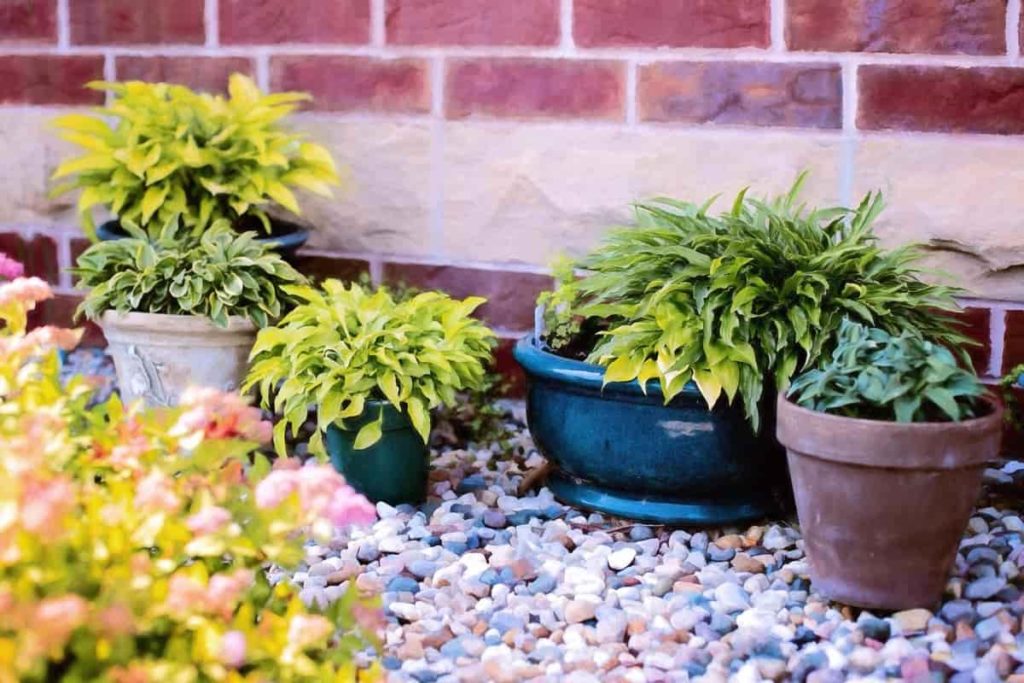
Clean your containers before planting – When your plants or seeds are ready, it’s time to plant them in containers. Maybe you bought new, reused an old one, or got some recycled ones for free. Containers can harbor insects and diseases from first use, so it’s a good idea to clean them thoroughly before use.
Keep your plants strong and healthy – Like humans, plants have immune systems protecting them from pests and diseases. You want to make sure your plants stay strong and healthy so they can fight off any pests and diseases that try to attack them. If your plants are stressed due to overwatering or waterlogging, they are prone to such problems. You also need to ensure they get the right nutrients every few weeks. You need to use a good organic fertilizer to feed your plants.
Conclusion
Container gardening is ideal for those with little or no garden space. In addition to growing flowers, gardeners can grow various vegetable crops in containers confined to a balcony, small yard, or just a patch of sun on their driveway. Pots and containers offer great versatility to the gardener and are a great way to experiment with planting and design. You can grow fruits, vegetables, flowers, herbs, shrubs, and small trees almost anywhere. Above are the tips for planting a container garden.
- Economical Aquaculture: A Guide to Low-Budget Fish Farming
- 15 Common Planting Errors That Can Doom Your Fruit Trees
- How to Make Houseplants Bushy: Effective Tips and Ideas
- Innovative Strategies for Boosting Coconut Pollination and Yield
- Pollination Strategies for Maximum Pumpkin Yield
- The Complete Guide to Chicken Fattening: Strategies for Maximum Growth
- Natural Solutions for Tulip Problems: 100% Effective Remedies for Leaf and Bulb-Related Issues
- Revolutionizing Citrus Preservation: Towards a Healthier, Greener Future
- Natural Solutions for Peony Leaf and Flower Problems: 100% Effective Remedies
- Maximizing Profits with Avocado Contract Farming in India: A Comprehensive Guide
- Natural Solutions for Hydrangea Problems: 100% Effective Remedies for Leaf and Flowers
- The Ultimate Guide to Choosing the Perfect Foliage Friend: Bringing Life Indoors
- From Sunlight to Sustainability: 15 Ways to Use Solar Technology in Agriculture
- The Ultimate Guide to Dong Tao Chicken: Exploring from History to Raising
- The Eco-Friendly Makeover: How to Convert Your Unused Swimming Pool into a Fish Pond
- Mastering the Art of Delaware Chicken Farming: Essentials for Healthy Backyard Flocks
- 20 Best Homemade Fertilizers for Money Plant: DIY Recipes and Application Methods
- How to Craft a Comprehensive Free-Range Chicken Farming Business Plan
- Brighten Your Flock: Raising Easter Egger Chickens for Beauty and Bounty
- How to Optimize Your Poultry Egg Farm Business Plan with These Strategies
- Subsidy for Spirulina Cultivation: How Indian Government Schemes Encouraging Spirulina Farmers
- Ultimate Guide to Raising Dominique Chickens: Breeding, Feeding, Egg-Production, and Care
- Mastering the Art of Raising Jersey Giant Chickens: Care, Feeding, and More
- Ultimate Guide to Raising Legbar Chickens: Breeding, Farming Practices, Diet, Egg-Production
- How to Raise Welsummer Chickens: A Comprehensive Guide for Beginners
- How to Protect Indoor Plants in Winter: A Comprehensive Guide
- Ultimate Guide to Grow Bag Gardening: Tips, Tricks, and Planting Ideas for Urban Gardeners
- Guide to Lotus Cultivation: How to Propagate, Plant, Grow, Care, Cost, and Profit
- Agriculture Drone Subsidy Scheme: Government Kisan Subsidy, License, and How to Apply Online
- Ultimate Guide to Raising Araucana Chickens: Breed Profile, Farming Economics, Diet, and Care
- Bringing Hydroponics to Classroom: Importance, Benefits of Learning for School Students
- Ultimate Guide to Raising Polish Chickens: Breed Profile, Farming Economics, Diet, and Care
- Ultimate Guide to Raising Australorp Chickens: Profile, Farming Economics, Egg Production, Diet, and Care
- Silkie Chicken Farming: Raising Practices, Varieties, Egg Production, Diet, and Care
- Sussex Chicken Farming: Raising Practices, Varieties, Egg Production, Diet and Care
- Homemade Feed Formulations for Livestock: Discover Cost-effective Starter to Finisher Feed Recipes